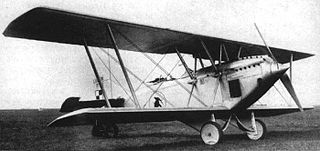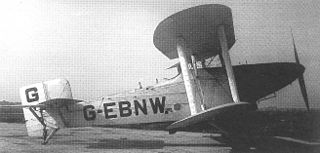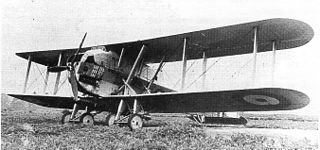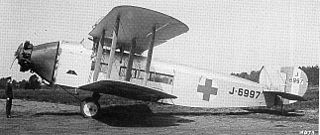
The Lublin R-VIII was a Polish bomber, reconnaissance aircraft and seaplane designed in the late 1920s by the Plage i Laśkiewicz factory in Lublin. It was the first in-house design of Plage i Laśkiewicz, and the first with the name Lublin.

The Hawker Tornado was a British single-seat fighter aircraft design of World War II for the Royal Air Force as a replacement for the Hawker Hurricane. The planned production of Tornados was cancelled after the engine it was designed to use, the Rolls-Royce Vulture, proved unreliable in service. A parallel airframe that used the Napier Sabre engine continued into production as the Hawker Typhoon.

The Westland Walrus was a British spotter/reconnaissance aircraft built by Westland Aircraft.

The Avro 555 Bison was a British single-engined fleet spotter/reconnaissance aircraft built by Avro.

The Blackburn R-1 Blackburn was a 1920s British single-engine fleet spotter/reconnaissance aircraft built by Blackburn Aircraft.

The Avro Type 584 Avocet was a British single-engined naval fighter prototype, designed and built by Avro. While the Avocet was not built in numbers, one of the prototypes was used as a seaplane trainer for the Royal Air Force's (RAF) High Speed Flight.

The Avro Club Cadet was a 1930s single-engined British biplane trainer aircraft, designed and built by Avro as a development of the earlier Cadet. It was planned for private and club use and, unlike the Cadet, was fitted with folding wings.

The Avro 571 Buffalo was a prototype British carrier-based torpedo bomber biplane, designed and built by Avro in the 1920s. It was not selected for service, the Blackburn Ripon being ordered instead.

The Avro 604 Antelope was a British light bomber which was designed and built in the late 1920s to meet a requirement for a light bomber to equip the Royal Air Force, competing against the Hawker Hart and the Fairey Fox II. It was unsuccessful, the Hart being preferred.

The Avro 627 Mailplane was a British biplane developed in 1931 by Avro from the Avro Antelope bomber as a mail plane for use in Canada. Only one was built which ended up being used as a test bed.
The Avro 636 was a single-engined British fighter-trainer built by Avro in the mid-1930s. Four were built for the Irish Air Corps.

The Avro 548 was a civil trainer aircraft built in Britain after World War I. Its design was based extensively on Avro's 504 military aircraft, but it had an inline engine and a third seat. The prototype, designated 545, first flew with a Curtiss OX-5 V-8 engine, but this proved impractical for the civil market on account of the engine's weight and the complexity of its cooling system. An air-cooled Renault engine was used instead, and the designation 548 applied to this configuration. In practice, these aircraft were usually customised for their buyers and most differed from each other in equipment and detail; some were actually retrofitted war-surplus 504s. Many were used as civil trainers, others for joyriding, personal transport, or racing.

The Blackburn T.4 Cubaroo was a prototype British biplane torpedo bomber of the 1920s. Built by Blackburn Aircraft and intended to carry a large 21 in (533 mm) torpedo, the Cubaroo was one of the largest single-engined aircraft in the world at the time of its first flight.

The Bristol Ten-seater and Bristol Brandon were British single-engine biplane transport aircraft built by the Bristol Aeroplane Company in the early 1920s. Only three were built, two of which were used as civil transports and one of which served with the Royal Air Force.

The Gloster SS.35 Gnatsnapper was a British naval biplane fighter design of the late 1920s. Two prototypes were built but the type did not enter production.

The Supermarine Sea Lion II was a British racing flying boat designed and built by the Supermarine Aviation Works for the 1922 Schneider Trophy at Naples, Italy which it went on to win. The earlier racing flying boat for the 1919 Schneider Trophy the Sea Lion I was a different design.

The Avro 530 was a British two-seat fighter biplane designed in 1916 to compete with the Bristol F.2A. The plane itself was designed in 1916, but not flown until July 1917. It was of fabric-covered wooden construction, powered by a 200 hp (150 kW) Hispano-Suiza engine.

The Gloster Gorcock was a single-engined single-seat biplane fighter aircraft produced to a United Kingdom Air Ministry contract completed in 1927. Only three were built.

The Gloster Guan was a single-engined single-seat experimental biplane fighter built in the United Kingdom to test the performance of fighters using supercharged engines at high altitudes. Three were planned but only two constructed.

The Wibault 12 Sirocco or Wib 12 Sirocco was a two-seat, parasol wing fighter aircraft designed and built in France in the 1920s. Three fighter prototypes were completed, one for the RAF and two Army co-operation variants. There was no series production.



















